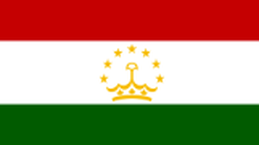- The official name of the country is Ҷумҳурии Тоҷикистон (Jumhuriyi Tojikiston), translated as the Republic of Tajikistan.
- Tajikistan is a very mountainous country located in Central Asia. It is the 96th largest country in the world in terms of area.
- Government. Tajikistan is officially a republic, and holds elections for the Presidency and Parliament. It is, however, a Dominant-party system, where the People's Democratic Party of Tajikistan routinely has a vast majority in Parliament.
- History. Tajiks are one of the most ancient peoples in the world. Archaeologists have dated settlements in the area to 15,000 to 20,000 years ago. Tajikistan was home of Sarazm of the Neolithic and the Bronze Age. Prehistoric rock drawings have been found in more than fifty places in Tajikistan, many of which are in the Pamir mountain area.
- Geography. Tajikistan is bordered by Afghanistan to the south, Uzbekistan to the west, Kyrgyzstan to the north, and China to the east. Pakistan lies to the south separated by the narrow wakhan corridor.
- Food. Traditional Tajik meals begin with halwa and tea, then soups and meat, and finishing with plov (a rice pilaf). The national dish is kabuli pulao, a rice dish with shredded yellow turnip or carrot, meat, and olive oil or drippings. Meals are ceremonies and food is treated with great respect. Bread is considered sacred. It must not be dropped on the floor and must be broken carefully, not cut with a knife.
- Etymology. Tajikistan means the "Land of the Tajiks". Stan is Persian for "place of" or "country". Tajik is probably the name of a pre-Islamic tribe, perhaps of Zoroastrian origin, and means "crown" or "royalty."
- Language. The Tajik language (also called Galcha) is very similar to Persian, spoken in Iran, and to Dari, spoken in Afghanistan. Isolated areas of the country have developed regional dialects and have only a rudimentary understanding of the official language. In the Pamiri mountain regions, various languages have kept many characteristics of ancient Iranian. Russian is preferred in government and business transactions, and Uzbeki is used widely in the Khujand region.
- Economy. Tajikistan is Central Asia's poorest country. The economy has not recovered from the civil war, and poverty is widespread. This poverty may be a contributing factor towards interest in radical Islam among young Tajiks.
- The Flag. The flag has a horizontal red stripe on top, a wider white stripe with a gold crown surmounted by seven stars in the middle, and a green stripe at the bottom. Those colors represent sunshine and health, chastity, the journey on the right path of life, peace and stability, agriculture, the mountains, and the spring. The crown shows a royal house, and the stars represent friendship between nationalities, class, unity, and Islam.
- Customs. The Tajiks have preserved many of the ancient traditions and customs of their ancestors. Hospitality is important. Elders are given the place of honor. Men may not enter a home where there are only women, a girl must never be left alone with a boy, men and women often are uysually separated at karge gatherings. One must stand when another guest enters. When greeting another person left hand is placed over the heart while shaking hands with the right hand and bowing slightly. Bartering is expected in the marketplace.
- Mountains. Tajikistan is a rugged country of mountains, bordered to the north and south by lush valleys. The Fann mountains are known as the "Gem of Pamirs" because of the many emerald green and turquoise lakes, surrounded by evergreen juniper grooves and snow capped peaks. There are more than 30 pure and variegated lakes of different size and shape.
- Dushanbe. Tajikistan’s capital is Dushanbe, in the western part of the country. The name means Monday, from the time when it used to hold market on Mondays. Things to visit in the city include the Ismaili Centre, Rudaki Park, and the National Museum of Tajikistan.
- Pamir Highway. One can Hire a driver to see this amazingly scenic panorama of mountains, hot springs and villages. It is rough driving and the high altitude can affect the unwary.
FRUA is a service-marked acronym of Families for Russian and Ukrainian Adoption in use since 1994. It and the full organizational name,
Families for Russian and Ukrainian Adoption, are not to be used to describe any organization or service not related to FRUA, without permission.
Families for Russian and Ukrainian Adoption, are not to be used to describe any organization or service not related to FRUA, without permission.
© 2023 Families for Russian and Ukrainian Adoption Including Neighboring Countries






